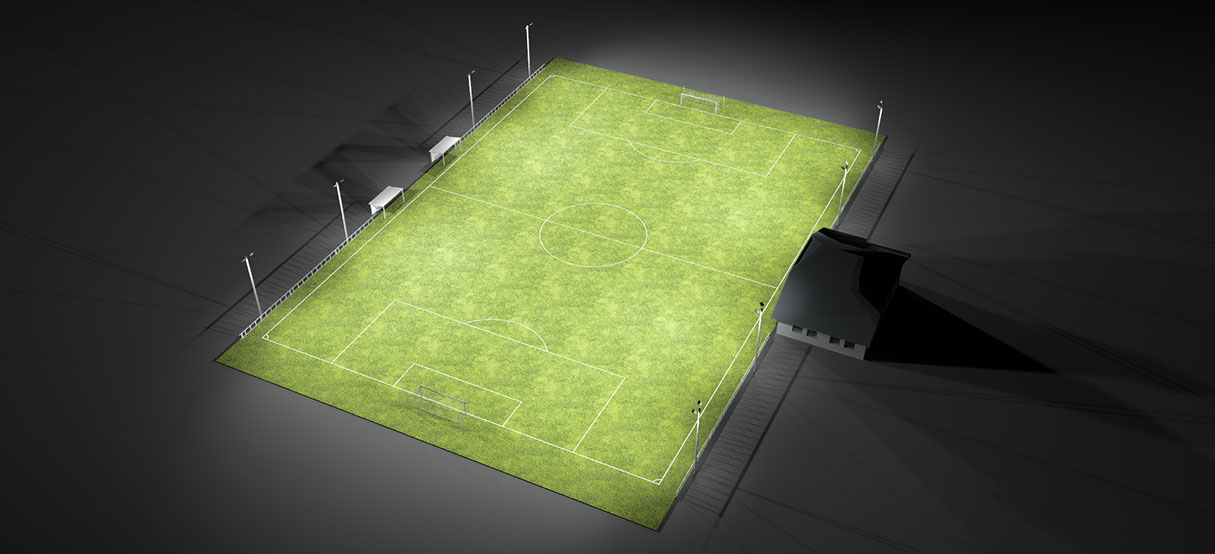How important is Space to Height Ratio in Outdoor Sports Lighting?

The space to height ratio in outdoor sports lighting is particularly important because it directly impacts the quality and effectiveness of the lighting in large, open areas like football pitches, rugby fields, tennis courts, or athletics tracks. In outdoor settings, factors like the size of the playing field, the height of the lighting columns, and how evenly light is spread across the area all play a role in ensuring that the sport can be played safely and efficiently, especially at night or under artificial lighting.
Here’s why it’s crucial in outdoor sports lighting:
Optimal Light Distribution
The space to height ratio helps in determining the ideal positioning of light fixtures to ensure that light is distributed evenly across the playing area. If the ratio isn’t well-calculated, some areas may be overlit while others could be underlit, leading to poor visibility for players, officials, and spectators.
Enhanced Visibility and Safety
In outdoor sports, where the lighting setup is often more spread out, it’s essential that the space is illuminated uniformly to prevent any dark spots on the field. This is especially important in sports where fast movement and ball tracking are crucial, like football or cricket. An improper ratio could result in shadows or glare, making it difficult for athletes to track the ball, or for referees to make accurate calls.
Avoidance of Glare
Properly calculating the space-to-height ratio reduces the risk of glare. In outdoor sports settings, if the lights are too high or too closely spaced, the intensity of light can cause discomfort or hinder a player's ability to see the game clearly. The right ratio helps achieve a balance between ensuring enough brightness without causing excessive light spill or direct glare.
Cost Efficiency
When the space-to-height ratio is correctly adjusted, fewer lights are needed, which can help reduce both installation and operational costs. By ensuring that the lighting is appropriately spaced and mounted at the correct height, you can reduce energy consumption while still maintaining the necessary illumination levels for the game.

Compliance with Regulations
Outdoor sports lighting needs to meet specific standards set by organisations like the International Cricket Council (ICC), FIFA, or World Athletics (formerly the IAAF), depending on the sport. These standards often specify how evenly the lighting should be distributed, the minimum illumination levels, and other factors that are influenced by the space-to-height ratio.
Weather and Environmental Considerations
Outdoor sports facilities have to account for weather conditions such as wind, rain, or snow, which can affect how light behaves across the field. The correct space-to-height ratio can help reduce the risk of these environmental factors compromising the effectiveness of the lighting.
Aesthetic Appeal
For large outdoor venues, especially those used for televised events, the aesthetic aspect of the lighting is also considered. The height and spacing of the lights contribute to the overall look of the venue, and a well-thought-out space-to-height ratio ensures a clean, professional appearance while also providing practical lighting solutions.
In summary, the space-to-height ratio in outdoor sports lighting is integral to ensuring that the lighting system is not only functional but also efficient, cost-effective, and compliant with industry standards. It affects everything from visibility and safety to energy usage and aesthetics, which is why it's carefully considered when designing lighting for outdoor sports facilities.
When calculating the Space to Height Ratio (SHR) for Sports Lighting, the principle is similar but applied to lighting pole placement. SHR is used to determine the uniformity and efficiency of lighting in sports fields.
Calculating SHR
Formula for SHR in Sports Lighting:

Steps to Calculate SHR for Sports Lighting:
- Measure the Distance Between Poles (m) – This is the horizontal spacing between two adjacent light poles.
- Measure the Mounting Height of Lights (m) – This is the vertical height from the ground to the light fixture.
- Apply the Formula – Divide the distance between poles by the mounting height.
Example Calculation:
- Distance between Poles = 40 meters
- Mounting Height of Lights = 20 meters

Interpreting SHR in Sports Lighting:
- SHR ≤ 2.0 → Good lighting uniformity
- SHR > 2.0 → Possible dark spots and uneven lighting
- SHR < 1.5 → Overlapping light, potential over-lighting






















